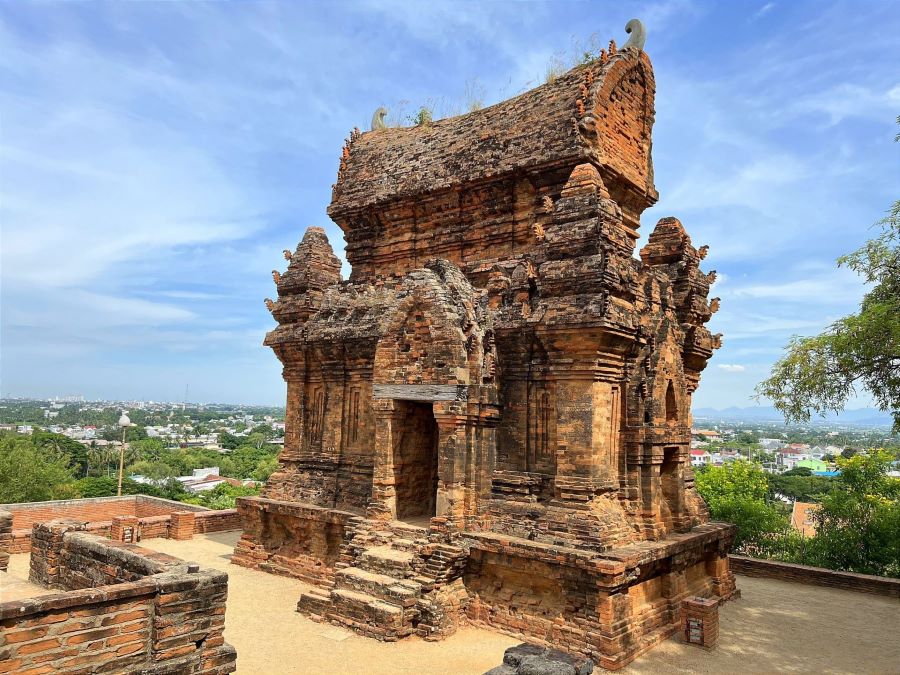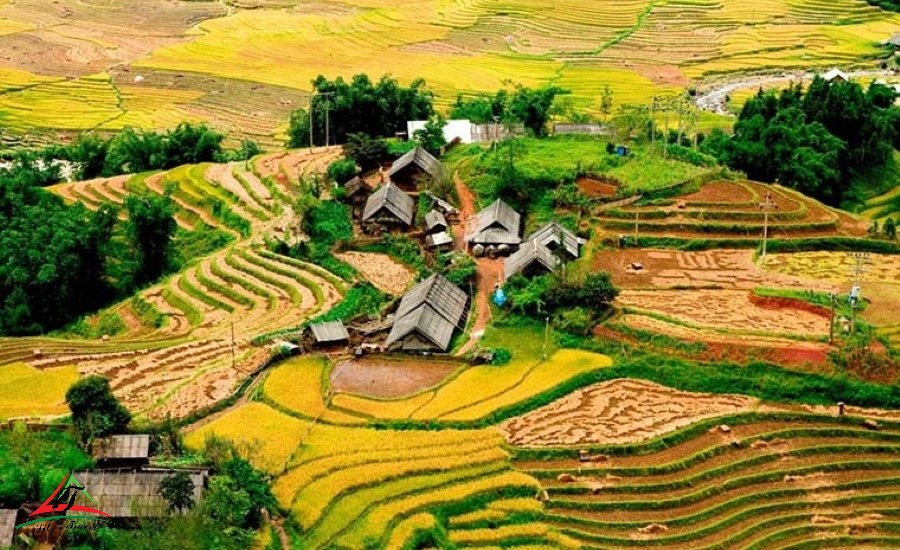Ta Van Village – Culture, Nature & Authentic Local Experiences
If you love adventure travel and being close to nature, Ta Van Village in Sapa is the perfect place for you. While it’s known for fun local activities, what truly captivates visitors is the untouched beauty and mysterious charm of the Northwestern mountains. To make the most of your trip, don’t miss out on the Vietnam travel tips we’re sharing from our own experience with Paradise Travel – from what to pack to how to read the Ta Van Village map like a local!
Travel to Northern Vietnam and explore Ta Van Village’s rich culture and nature.
Getting to Know Ta Van Village
Ta Van Village is a small, charming village in the Sapa region of Lao Cai Province. Although officially classified as a commune, most travelers simply refer to it as a village. Located about 12 kilometers from Sapa town center-measured from the famous Stone Church-it’s an easy and scenic drive along Cau May Street. The mountain road to Ta Van offers stunning views and a peaceful atmosphere, making it a perfect escape into nature.
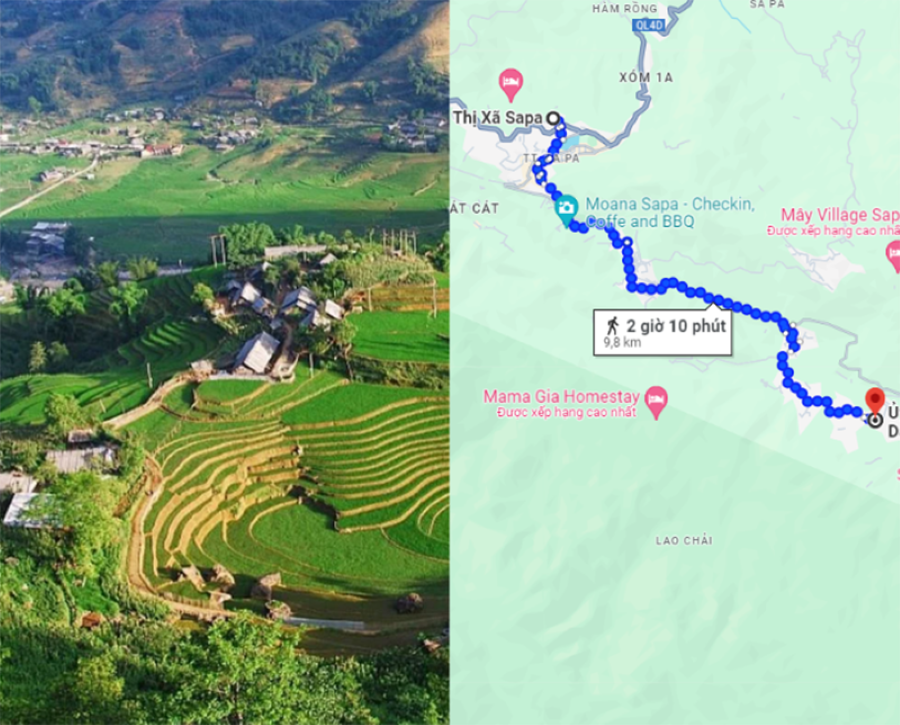
Explore Ta Van Village using this map of paths, homes, and hills.
This Village rests peacefully with its back against the majestic Hoang Lien Son range and its front facing the dreamy Muong Hoa Stream. As we arrived, the winding stream flowed gently beside us, sometimes near, sometimes far, filling the air with a soft, calming sound. Surrounded by the raw beauty of Northwest Vietnam, we couldn’t help but fall in love with the simple charm of the mountains and the feeling of truly being in nature.
Ta Van is home to several ethnic groups of Northwest Vietnam, especially the Hmong, Giay, and Red Dao people. In the Hmong language, “Ta Van” means “a large arc,” which reflects both the geography and traditional way of life here. Locals live in small villages nestled at the base of the hills, following the curve of the valley along the river. In the distance, beautiful terraced fields stretch across the mountain slopes, completing this peaceful, scenic landscape.

Colorful lives of northwest ethnic groups flourish in Ta Van Village daily.”
The best time to visit Ta Van
Each season brings its own charm-sometimes dreamy with soft clouds drifting through the hills, other times glowing with golden rice fields during harvest. Before your trip, it’s a good idea to learn about the seasons so you can pick the time that suits your travel style best. Here’s a quick guide:
Cloud Hunting Season
Cloud hunting season is best from September to April, during the coldest months of the year. In the early morning or late afternoon, layers of soft white clouds-light as cotton-cover the sky above the Northwest mountains, creating a peaceful and romantic scene. It’s a favorite time for young travelers looking to discover something magical and different in the highlands.

Clouds drift like silk over Ta Van Village in magical hunting season.
Golden Rice Season
Golden rice season peaks around September and sometimes again in April. During this time, the entire village transforms into a sea of gold under the open sky. The weather in Sapa is usually dry and pleasant, perfect for exploring and capturing stunning shots of the glowing rice terraces. It’s also the busiest season of the year here, as travelers from everywhere come to admire the romantic and breathtaking landscape.

Ta Van Village glows warmly under the golden rice season’s gentle sun.
Irrigation Season
Water-pouring season lasts from May to June and is quite short, so timing your visit is important. During this period, the terraced rice fields fill with clear, glistening water. From a distance, the landscape looks like a giant mirror or a shimmering golden carpet stretching across the valley. It’s a truly unforgettable sight for nature lovers and adventure seekers alike.

Ta Van Village glistens as water flows through rice fields in harmony.
Plum Blossom Season
Plum blossoms in this region bloom a bit later than in Bac Ha, peaking around mid-February. The flowers come and go quickly, lasting only 2 to 3 weeks at most. If you visit at the right time, you’ll walk through dreamy white blossoms with a soft mountain fragrance in the air. It’s the perfect season for romantic souls and photo lovers who want to capture nature’s quiet beauty.

In Ta Van Village, plum blossoms dance softly in the mountain breeze.
Entrance Fee to Ta Van Village
| Category | Details | Price (VND) | Price (USD) |
| Entrance Fee | Adult ticket | 75,000 VND | ~3 USD |
| Child ticket (under 1m free) | 50,000 VND | ~2 USD | |
| Traditional Outfit Rental | Includes scarf, accessories | 50,000–100,000 VND | ~2–4 USD |
| Motorbike Rental | Full-day rental to explore around Ta Van Village | 100,000–150,000 VND | ~4–6 USD |
| Beverages & Coffee | At local cafes along the valley (coffee, juice, smoothies, etc.) | 30,000–50,000 VND | ~1.2–2 USD |
7 Must-Try Experiences in Ta Van Village
Admire the Golden Rice Terraces
Watching the terraced rice fields in Ta Van during harvest is a truly unforgettable experience. The scent of ripe rice drifting in the breeze, combined with endless layers of golden fields curving along the Hoang Lien Son mountain slopes, will leave you speechless. What makes Ta Van’s terraces special is their raw, untouched beauty-completely in harmony with the wild, majestic landscape of Northwest Vietnam. It’s no surprise this peaceful corner is a highlight of our Hidden North Vietnam Discovery in 13 Days journey.
Tips for Enjoying the Golden Rice Terraces in Ta Van:
- Scenic welcome right from the gate:
As soon as you pass the ticket checkpoint, you’ll be greeted by endless golden rice fields-perfect for soaking in the view and snapping stunning photos with friends or family. - Dress smart and stylish:
Wear warm, lightweight clothing that’s easy to move around in. For beautiful photos, consider renting traditional ethnic costumes-they’re colorful and look amazing against the golden fields! - Plan ahead during peak season:
The harvest season attracts many visitors, so it’s best to book transportation, lunch spots, or homestays in advance to avoid last-minute stress.
Check In at the Iconic Cau May (Cloud Bridge)
The new Cau May Bridge in Ta Van is around 20 years old and has become a beloved check-in spot for visitors seeking something both rustic and memorable. To get there, you can follow a narrow trail along the Muong Hoa Stream for about 3 kilometers from Lao Chai Village. The bridge, made of bamboo planks and ropes, gently sways under your feet, adding a little thrill to the experience without feeling unsafe.
If you’re short on time but want to soak in the natural beauty of Northwest Vietnam, this is the perfect stop. For the best photo, stand about one-third of the way across the bridge, close to the wooden planks near the center, and pose facing the ancient tree at the far end. This angle captures the full charm of the surroundings and often results in what we call a “million-like” shot.
To avoid crowds and catch the best light, plan your visit between 7:00 and 9:00 AM. The soft morning sun, the calm air, and the quiet setting will make your moment on Cau May feel like a peaceful escape into nature.
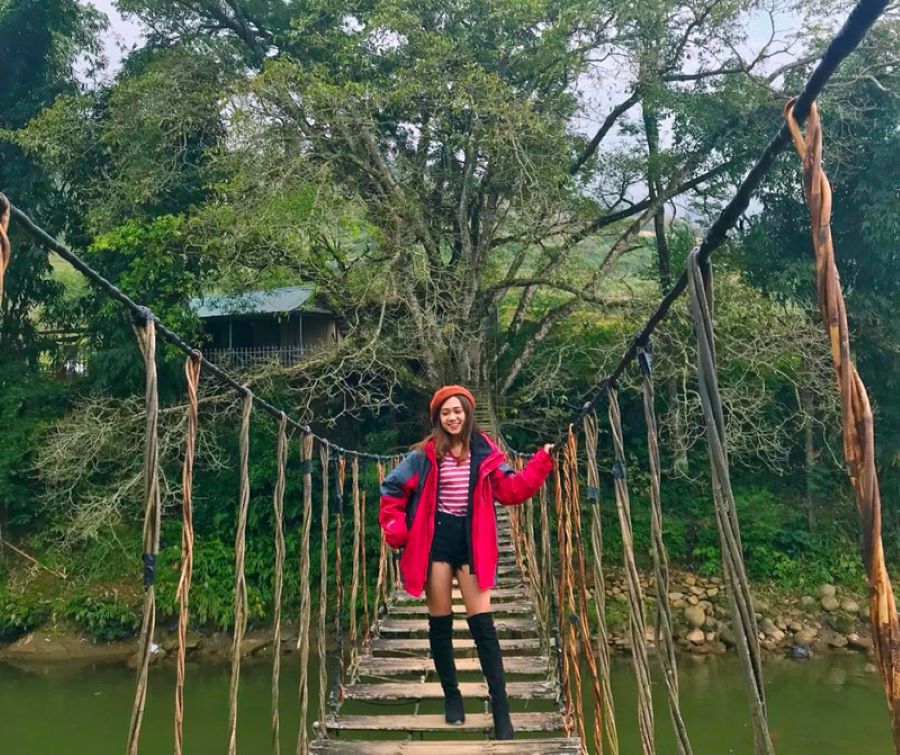
Strike a pose on Cau May, above peaceful Ta Van Village.
Explore the Unique Traditional Homes of Ethnic Minorities
Learning about the traditional homes and architecture of local people in Ta Van is a great way to better understand the region, its culture, and the values passed down through generations. Scattered throughout the village, these houses reflect the lifestyle and customs of the ethnic minorities who live here.
If a particular house catches your eye, don’t hesitate to ask the locals for permission to step inside. Most are welcoming and happy to share stories about their daily life and heritage.
For a deeper dive, visit the homes of elders like Mr. Hoang Din or Lo A Muc. Their wooden stilt houses, built more than 90 years ago, represent the traditional architecture of the Giay people-with forest wood frames and compacted earth floors. These homes are not just places to live; they are living pieces of history.
Tips for Visiting Traditional Ethnic Homes in Ta Van:
- Always ask for permission before entering someone’s home or taking photos, out of respect for local customs.
- Be mindful of your behavior-do not touch, move, or rearrange household items without being invited to.
- Do not write on walls or leave marks, drawings, or damage in any form. These homes hold deep cultural and personal value.
- Help keep the space clean-treat every home as if it were your own.
Visit Ta Van Giay Village – The Oldest Hamlet in the Area
Known as the oldest village in Ta Van, Ta Van Giay has a history stretching back nearly 300 years, since the first Giay families settled and cultivated the land. Even today, the village preserves many original customs and traditions that have been passed down through generations.
When you visit, you’ll feel the calm and purity of a highland village untouched by modern chaos. The Giay people here are especially known for their delicate handmade silver jewelry and beautifully crafted traditional clothing worn by the women-each piece a work of cultural pride.
It’s best to visit Ta Van Giay between 8:00 and 9:00 AM, when the air is fresh, the village is peaceful, and roads are easier to navigate. The path into the village is a bit deep, with some narrow dirt trails, so having steady driving skills helps a lot. If you’re on a Northwestern Vietnam Short Motorbike Trip, this stop is both scenic and culturally rich-just be sure to ask locals for directions to avoid getting lost along the way.
Join a Traditional Highland Market in Ta Van
Highland markets in Ta Van are a must-see for travelers looking to dive into the region’s rich culture and lively local life. These markets are full of energy and color, offering visitors the chance to shop, eat, and explore all in one place.
At the Ta Van weekend market, you’ll find handwoven textiles, ethnic souvenirs, and locally made crafts that you won’t see anywhere else. Villagers also sell fresh produce, homemade goods, and seasonal specialties straight from their gardens and farms-perfect for those seeking something authentic.
The market usually takes place on weekends and wraps up by around 1:00 PM, so it’s best to visit early in the morning to catch the full experience. If you’re on a Sapa markets tour, don’t skip this stop-it’s one of the most vibrant and genuine cultural encounters you’ll find in the highlands.

Highland market days in Ta Van Village celebrate ethnic life and trade.
Shop for Handwoven Textiles and Local Souvenirs
While exploring Ta Van, you’ll come across plenty of lovely handcrafted items made by local ethnic artisans-perfect Vietnam souvenirs to take home or thoughtful gifts for friends and family. From small accessories to traditional handwoven textiles, each piece carries the charm and cultural essence of the region.
You can shop at souvenir stalls along the village entrance, in cozy cafés, homestay gift corners, or at weekend markets. Prices may vary, so it’s a good idea to politely ask before buying to ensure a fair deal.
One important note: please avoid buying from or giving money to children selling goods on the street. Supporting their right to play, learn, and grow is just as important as supporting the local culture.

Ta Van Village weaves culture and color into every thread of textile art.
Try the Traditional Herbal Bath of the Red Dao People
When visiting Ta Van, you won’t just enjoy breathtaking mountain views-you’ll also get a chance to connect with local traditions, including the Red Dao people’s famous herbal bath.
Nestled beneath the Hoang Lien Son range, Ta Van is home to a rich ecosystem. For generations, the Red Dao have gathered wild herbs from the forest and used them to create healing baths. These traditional herbal remedies are believed to boost energy, improve circulation, and relieve muscle pain.
The herbal bath has become a must-try experience for visitors. You’ll find many options throughout the village-from local spas and homestays to Red Dao family houses. Prices usually range from 80,000 to 100,000 VND (around $3–$4 USD) per tub, depending on the location and view.
Things to Keep in Mind When Experiencing the Red Dao Herbal Bath:
- Avoid bathing on an empty or overly full stomach: It may cause dizziness or nausea. A light snack about 30 minutes before the bath is recommended.
- Pregnant women should not bathe: To ensure safety for both mother and baby.
- People with skin or health issues should take caution: If you have eczema, allergies, infections, or large open wounds, it’s best to avoid the herbal bath to prevent worsening the condition.

In Ta Van Village, Red Dao herbal baths soothe body and soul.
What to Eat in Ta Van Village?
While exploring the beautiful corners of Ta Van Village, take a break and enjoy some delicious local specialties at these 4 must-try dining spots.
Ta Van Village Weekend Market
The local weekend market in Ta Van Village offers a unique cultural experience with its vibrant atmosphere and delicious traditional food. Here, visitors can taste a variety of ethnic specialties such as corn cakes, five-color sticky rice, “bánh chưng gù” (a hump-shaped sticky rice cake), steamed rice cakes, pickled bamboo shoots, and fresh mountain vegetables like “cải mèo.”

In Ta Van Village, Bánh Chưng Gù preserves flavors of the past.
All dishes are homemade and sold by local villagers at very affordable prices, ranging from 20,000 – 50,000 VND (approximately $0.80 – $2.00 USD) depending on the type and portion size. However, the local market only takes place on weekends, from early morning until around midday, so visitors should plan their time accordingly.
The market doesn’t offer scenic views or the spacious, attentive service you’d find in a restaurant. Instead, it has a casual, street-food vibe that reflects the local culture. You can stop by any food stall run by the villagers, grab a bite to go, or enjoy your meal right on the spot to fully experience the flavors of the highlands.
Toan Man Restaurant
Toan Man Restaurant (Tả Van Giáy 2) is a popular local eatery in Tả Van, loved by many tourists and known for its 5-star ratings.
Though modest in size, the restaurant is clean, well-organized, and run by friendly, attentive staff.
The menu features a wide variety of dishes, including:
- Local specialties like sturgeon hotpot and grilled chicken
- Homestyle meals with rice, soups, and sautéed dishes
- Unique options such as vegetarian hotpot and rice noodles with lemongrass soy sauce
Transparent pricing – no hidden service fees:
- À la carte dishes range from 50,000 – 180,000 VND (~$2.00 – $7.00 USD)
- Hotpot sets for 2–3 people range from 350,000 – 500,000 VND (~$14.00 – $20.00 USD)
Tip: The restaurant is often busy and the space is limited, so it’s best to book a table in advance to avoid waiting.
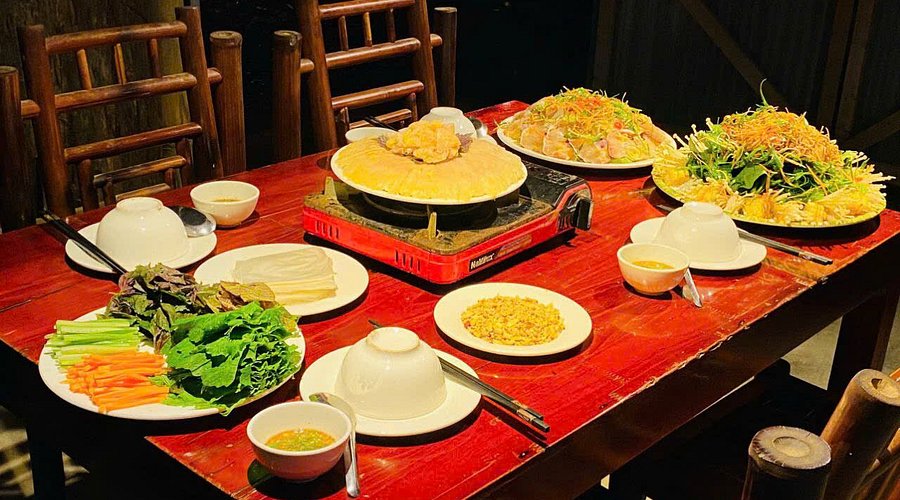
Dine at Toan Man, Ta Van Village’s spot for authentic local cuisine.
Ta Van Restaurant
Ta Van Restaurant is a must-visit dining spot in Tả Van village, known for:
- Spacious and airy atmosphere
- Beautiful view of terraced fields and mountains
- Aromatic grilled dishes with eye-catching presentation
Signature dish:
- Sturgeon hotpot – featuring fresh, tender pink sturgeon combined with forest vegetables and mushrooms for a refreshing and flavorful meal.
- Diverse menu with prices ranging from 100,000 – 300,000 VND (approximately $4.00 – $12.00 USD).
Advance booking available:
- Guests can pre-order hotpot sets for 2 or more people – ideal for couples, friends, or families.
Note:
- The restaurant can get crowded during peak tourist seasons.
- It’s best to arrive early to grab a good seat and ensure quick service.
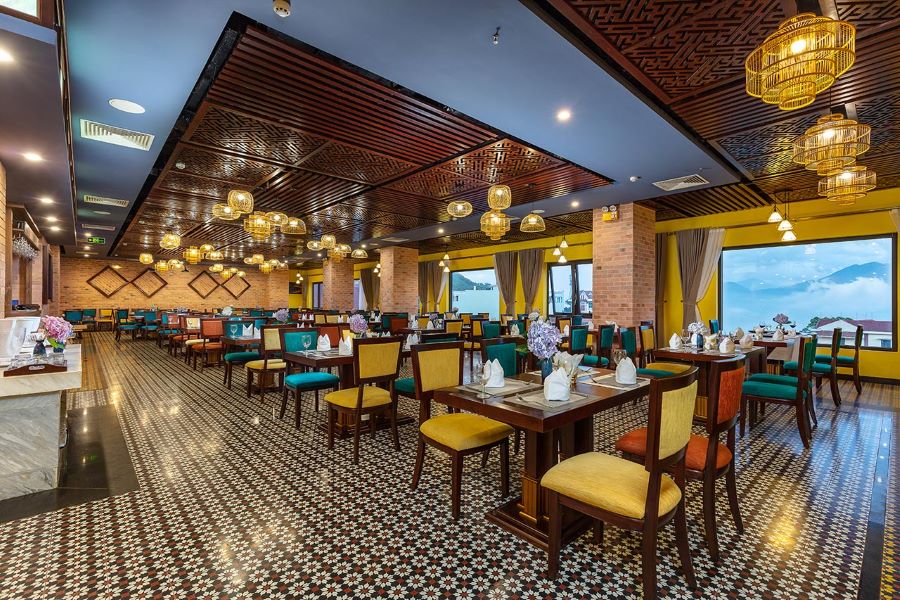
Ta Van Village welcomes you with warm meals at Ta Van Restaurant.
La Dao Spa & Coffee House
La Dao Spa & Coffee House is one of the most popular spots in Ta Van, especially among young travelers, thanks to its cozy Northwest-inspired decor and interior design.
At the restaurant, you can enjoy a variety of delicious local dishes such as:
- Grilled chicken
- Bamboo-tube rice (cơm lam)
- Traditional chicken platter (mẹt gà)
- Hill pork
- Stir-fried chayote (su su xào)
- Sturgeon or salmon hotpot
The café area is also known as the most picturesque coffee spot in Tả Van village, offering:
- Fresh juices, herbal teas, and coffee
- A stunning view overlooking the surrounding mountains and forests — perfect for a peaceful retreat or Instagram-worthy moment.
Prices for food and drinks range from 50,000 to 200,000 VND (approximately $2.00 – $8.00 USD).
No surcharge is applied during holidays or peak seasons.

Sip local brews at Lao Dao, nestled in Ta Van Village
Our Favorite Homestays in Ta Van, Sapa
During our trip to Ta Van village, we stayed in a few cozy, locally-run homestays that we absolutely loved. Each place had its own charm – from stunning views to peaceful vibes and friendly hosts. Here’s a little breakdown of our favorite stays if you’re planning your own Sapa adventure:
Tavan View Homestay
Located right in the heart of Ta Van Giay, this place felt like home from the moment we arrived. The rooms range from shared dorms (for 8 people) to comfy private spaces including double rooms, family rooms, and even bungalows.
Price: Around 400,000 – 2,000,000 VND per night (~$16–$78)
Check-in/out: 12:00 AM – 10:30 AM
Extras: Free Wi-Fi, water, an on-site restaurant, and a spacious garden area.
Rating: ★★★★☆
Contact: +84 91 459 1424
Comlam Eco House
Set in Lao Chai, just a short ride from central Ta Van, this eco-lodge has a peaceful vibe and incredible mountain views. The rooms are simple but lovely — doubles, family rooms, and cozy bungalows.
Price: 450,000 – 550,000 VND per night (~$18–$22)
Check-in/out: 12:00 AM – 11:00 AM
Highlights: Shared space, café, a small restaurant, and dreamy landscapes.
Rating: ★★★★☆
Contact: +84 86 659 9588
Hnee House Ta Van
Nestled in Ta Van Giay, this family-style homestay won us over with its attention to detail and warm hospitality. We stayed in a double room, but they also offer family rooms and wooden bungalows.
Price: 720,000 – 900,000 VND per night (~$28–$36)
Check-in/out: 11:00 AM – 10:00 AM
Perks: Free tea, coffee, bottled water, and high-speed Wi-Fi.
Rating: ★★★★☆ (4.2)
Contact: +84 385 339 093
How to get there?
Getting to Ta Van Village isn’t too tricky at all. The road is a mountain pass, but it’s open and surprisingly easy to navigate. If you’re confident on two wheels and love winding mountain routes, renting a motorbike is a great option. However, if you’re new to driving in the northern highlands, the steep curves might be a bit overwhelming. In that case, taking a taxi or choosing a Vietnam car rental with driver is a smart and comfortable alternative – no need to worry about directions or road conditions.
From Sapa’s iconic stone church, head toward Cau May Street (the lively backpacker area), then continue along Muong Hoa Road beside the stream. You’ll reach the ticket checkpoint for Ta Van after a scenic ride. From there, just follow the signs about 1 km further and you’ll see a charming red bridge over Muong Hoa Stream – your gateway to the village.
And if you’d rather sit back and enjoy the views without focusing on the road, hiring a local tour guide or booking a Vietnam car rental with driver can make the trip more relaxing, letting you truly take in the peaceful beauty of the Northwest.
Don’t Miss Ta Van on Your Vietnam Tours
If you’re dreaming of misty mountains, peaceful rice terraces, and authentic cultural encounters, Ta Van Village is the perfect escape from the busy tourist trails. Whether you’re into nature, photography, food, or simply slowing down and soaking in local life, this hidden gem has something truly special to offer.
Instead of navigating it all on your own, consider joining a well-curated trip that includes Ta Van in the itinerary. With a local guide by your side, you’ll not only explore the village more deeply, but also gain insights into the traditions, stories, and daily lives of the people who call it home.
A good tour takes care of the details – transportation, tickets, local connections – so you can focus on enjoying the experience. Trust us, it’s the kind of place that stays with you long after your journey ends. So pack your bags and let Ta Van Village be part of your unforgettable Vietnam tours adventure.
FAQs
Walking: about 2–3 hours through terraced rice fields, ideal for nature lovers.
Motorbike or taxi: about a 30-minute ride from Sa Pa center, more convenient and quicker.
Start planning your tailor-made Vietnam tour by contacting one of our specialists…



